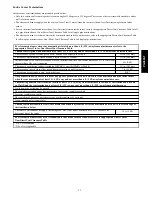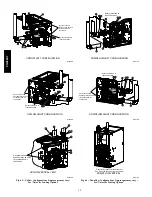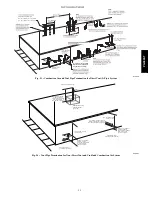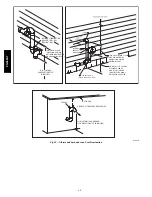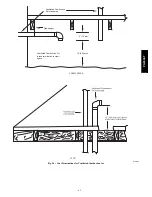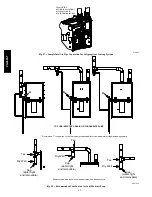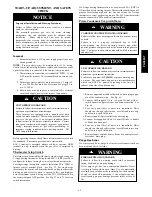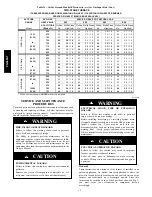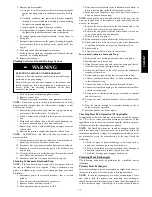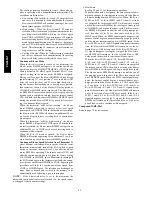
67
3. Connect an amp. meter across the R and W subbase
terminals or R and W wires at wall.
4. Record amp. draw across terminals when furnace is in low
heat and after blower starts.
5. Set heat anticipator on thermostat per thermostat
instructions and install on subbase or wall.
6. Turn SW--1 (LHT) switch OFF.
7. Install blower access door.
Electronic thermostat
: Set cycle rate for 3 cycles per hr.
Check Safety Controls
The flame sensor, gas valve, and pressure switch were all checked
in the Start--up procedure section as part of normal operation.
1. Check Main Limit Switch
This control shuts off
combustion system and energizes air--circulating blower
motor, if furnace overheats. By using this method to check
the temperature limit control, it can be established that the
limit is functioning properly and that the limit will operate if
there is a restricted return--air supply or motor failure. If the
limit control does not function during this test, the cause
must be determined and corrected.
a. Run furnace for at least 5 minutes.
b. Gradually block off return air with a piece of cardboard or
sheet metal until the limit trips.
c. Unblock return air to permit normal circulation.
d. Burners will re--light when furnace cools down.
2. Check Pressure Switch(es)
This control proves operation of the draft inducer blower.
a. Turn off 115--v power to furnace.
b. Disconnect inducer motor lead wires from wire harness.
c. Turn on 115--v power to furnace.
d. Set thermostat to “call for heat” and wait 1 minute. When
pressure switch is functioning properly, hot surface igniter
should
NOT
glow and control diagnostic light flashes a
status code 32. If hot surface igniter glows when inducer
motor is disconnected, shut down furnace immediately.
e. Determine reason pressure switch did not function proper-
ly and correct condition.
f. Turn off 115--v power to furnace.
g. Reconnect inducer motor wires, replace outer door, and
turn on 115--v power.
h. Blower will run for 90 sec before beginning the call for heat
again.
i. Furnace should ignite normally.
Checklist
1. Put away tools and instruments. Clean up debris.
2. Verify that the jumper is removed from the TEST/TWIN
terminal. Verify that there is nothing plugged into the PLT
connector. (Note: If there is a jumper connector plugged
into PLT, remove it and discard.) See Fig. 38.
3. Verify that Heating Operating Mode switch SW-1 is set
properly. See Fig. 38.
4. Verify that the Blower/Heat Off Delay SW-2 and SW-3
switches are set as desired. See Fig. 38.
5. Verify that there are no unsealed openings in the blower
shelf or casing.
6. Verify that the blower (lower door in upflow position) and
control (“Main” or upper door in upflow position) doors are
properly installed.
7. Verify that the Status LED glows. If not, check that the
power supply is energized and that the blower door is
secure. See Fig. 62 to interpret diagnostic codes.
8. Cycle test furnace with room thermostat to be sure that it
operates properly with the room thermostat. Check all
modes including Heat, Cool and Fan.
9. Check operation of accessories per manufacturer’s
instructions.
10. Review Owner’s Manual with owner.
11. Attach entire literature packet to furnace.
ON/OFF Switch
Regulator Seal Cap
Regulator Adjustment
Regulator Seal Cap
under Cap
1/2” NPT Outlet
1/8” NPT Manifold
Pressure Tap
1/8” NPT Inlet
Pressure Tap
1/2” NPT Inlet
TWO-STAGE
Representative drawing only, some may vary in appearance.
Gas Valve without Tower Pressure Ports
A11152
INLET PRESSURE TAP
SET SCREW: 3/32” HEX HEAD
ACCEPTS 5/16” HOSE
CONNECTION
ON/OFF SWITCH
MANIFOLD PRESSURE TAP SET SCREW:
3/32” HEX HEAD ACCEPTS
5/16” HOSE CONNECTION
REGULATOR SEAL CAP
(REGULAR ADJ. UNDER CAP)
OUTP
1/2” NPT
INLET
1/2” NPT
OUTLET
Representative drawing only, some models may vary in appearance.
A170117
Fig. 59 -- Gas Valve with Tower Pressure Ports
BURNER
ORIFICE
A93059
Fig. 60 -- Orifice Hole
PG95X
AT

